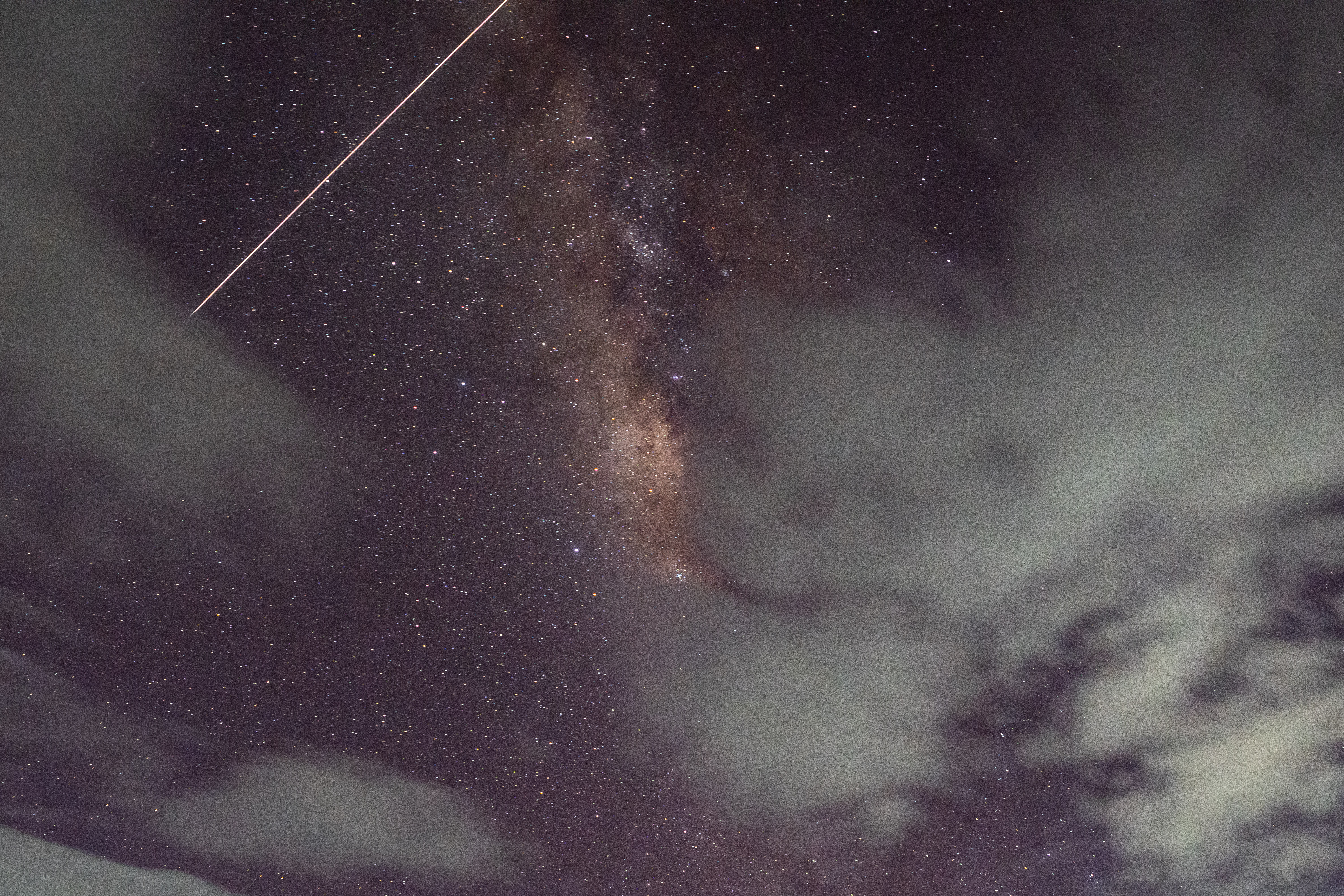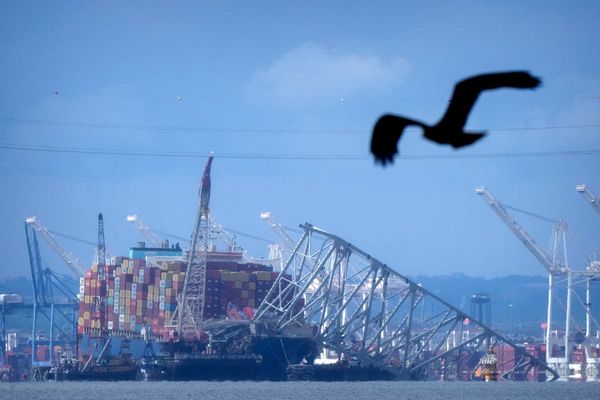
If your weather is clear this evening, we invite you to step outside and stare upward anytime from one to two hours after sundown.
If you're fortunate to be located well away from any bright lights, break out a long lounge or deck-chair and get comfortable. Once your eyes have fully adapted to the dark, you might be able to count several hundred stars of varying degrees of brightness.
But you also may also see some other interesting sights, including the largest and brightest object now orbiting Earth: the International Space Station.
Related: Track the ISS: How and where to see it
Perhaps you'll catch a glimpse of an extraterrestrial intruder; a sudden streak of light, lasting no more than a second or two at most and possibly leaving a brief incandescent trail in its wake.
Ancient stargazers believed that such a sight was a star falling from its fixed position in the sky. We call these meteors today, although the term "falling star" and "shooting star" are still widely used. Such objects are usually particles no larger than a pebble or sand grain, that crash into our upper atmosphere at high speeds of up to 45 miles (72 km) per second; their kinetic energy is converted almost instantly to light creating the effect of a shooting star. Most meteors first appear at an altitude of 80 miles (130 km) and disappear about a second later at perhaps 40 miles (65 km).
Then there are another group of intruders that have been with us since the start of the space age, some 67 years ago: Artificial satellites.
Unlike meteors, they are far larger: Actually, man-made structures that circle our Earth and cruise in orbits around our home planet at average speeds of "only" 5 miles (8 km) per second.
Perhaps the best visual description for a satellite was by the late veteran British satellite observer, Desmond King-Hele (1927-2019). In his excellent book, "Observing Earth Satellites" (Van Nostrand Reinhold Company, 1983), he wrote: "A satellite looks like a star that has taken leave of its senses and decided to move off to another part of the sky."
Satellites are seen at night because their metallic skins are illuminated by the sun. A satellite entering Earth's shadow immediately vanishes from view and pursues an unseen path until it again emerges into full sunlight.

How many?
Right now, there is a fair chance that if you go out and carefully study the sky between 30 minutes and two hours after sunset, or from two hours to 30 minutes before sunrise, you will sight as many 15 to 30 satellites, ranging in brightness from as bright as the brightest stars (zero or first magnitude) down to moderately faint objects of around fourth magnitude. This should not be too surprising when you consider just how many objects are now circling Earth.
The very first satellite was Sputnik 1, launched in October 1957. Since then, there are now roughly 9,500 satellites now in orbit around Earth. Most of these are active payloads, but there are also 100 million pieces of "space junk" ranging in size from as large as 30 feet, down to about the size of a softball, and literally millions more smaller pieces that could nonetheless prove disastrous if they hit another orbiting object. U.S. Space Command in Colorado Springs, Colorado keeps a constant watch on all orbiting debris.
Most satellites are too faint to be seen with the unaided eye. But depending on whose counting, several hundred or more can be seen with the unaided eye. These are the satellites that are large enough (over 20 feet or 6 meters in length) and low enough (100 to 400 miles or 160 to 640 km above Earth) to be most readily seen.
The biggest!

Looking for a telescope to see the ISS in the night sky? We recommend the Celestron Astro Fi 102 as the top pick in our best beginner's telescope guide.
By far the biggest and brightest of all the man-made objects orbiting the Earth is the International Space Station (ISS), which was assembled and is currently maintained by the United States, Russia, the European Space Agency, Japan and Canada. The station's solar arrays measure 240 feet (73 meters) in width, which rivals the wingspan of a Boeing 777. The station itself is 357.5 feet (108 meters) in length or just one yard shy of the full length of a football field, including the end zones. It weighs 925,335 pounds (462.7 tons).
Circling the Earth at an average altitude of 260 miles (420 km) and at a speed of 17,500 miles (28,200 km) per hour, it can appear to move as fast as a high-flying jet airliner, sometimes taking as much as six or seven minutes to cross the sky. It can easily be confused with aircraft lights.
Nominally, it appears white with a slight yellow tinge and nominally its visual magnitude can reach a brilliant –1.8 (rivaling Sirius, the brightest star in the night sky) though at its very brightest it can sometimes appear to shine as bright as magnitude -5.6, which is twice as bright as the planet Venus!
While the ISS looks like a very bright moving star to the unaided eye, those who have been able to train a telescope on it have actually been able to detect its T-shape as its whizzed across their field of view. Some have actually been able to track the ISS with their scope by moving it along the projected path. Those who have gotten a good glimpse describe the body of the space station as a brilliant white, while the solar panels appear a coppery red.
Put simply: If the ISS is moving across your sky, it's all but impossible to miss!

Many viewing windows of opportunity
From now through the end of May, North Americans will get many opportunities to see the ISS flying over their homes, due chiefly to a seasonal circumstance. As we approach the summer solstice on June 20, nighttime hours are growing short and the time that a satellite in a low-Earth-orbit (like the ISS) can remain illuminated by the sun can extend well into the night, a situation that can never be attained during other times of the year.
Because the ISS circles the Earth about every 90 minutes on average, this means that it's possible to see it not just on one singular pass, but for several consecutive passes.
For most locations there are two types of passes that are visible. In one case, the ISS initially appears over toward the southwestern part of the sky and then sweeps over toward the northeast. But on other occasions it becomes possible to see a second type of pass, with the ISS initially appearing over toward the northwestern part of the sky and sweeping over toward the southeast.
In the most extreme cases, you might be able to catch the ISS as many as four times or more during a single day!
Case in point: From New York City on Friday, May 10, the ISS will take about 3.5 minutes to skim low above the north-northeast horizon from north-northwest to northeast beginning at 2:08 a.m. EDT. A somewhat higher pass, taking a northwest to east-southeast trajectory and lasting for nearly 5 minutes will commence at 3:44 a.m. Later that evening, at 10:01 p.m., a noticeably higher, brighter and longer pass will begin in the west-southwest and will conclude nearly 7 minutes later in the northeast. Along the way, the ISS will climb two-thirds of the way up from the north-northwest horizon to the point directly overhead.
Later that same evening, the ISS will make a much lower pass, taking 2 minutes to track from west-northwest to north-northwest beginning at 11:39 p.m. The ISS will then quickly fade out as it enters the shadow of Earth.

Just where and when should you look?
So, what is the viewing schedule for your particular hometown? You can easily find out by visiting one of three popular websites:
- Spot the Station - This site will tell you when and where to sight the ISS. All you need do is type in your city or town, then click on the map pinpoint to get all the details. You can even sign up to get email or text alerts when the space station is flying over.
- Chris Peat's Heavens Above - This site will not only provide you with sighting information for the ISS, but also for Tianhe-1 as well. You must first register and then you can input your location to generate a sighting schedule.
- Live Real Time Satellite Tracking - Like Heavens Above, you can get sighting information for both the ISS and Tianhe-1. Once you log on this site will automatically provide details based on your IP address, or you can set a "custom" location.
Predictions computed a few days ahead of time are usually accurate within a few minutes. However, they can change due to the slow decay of the space station's orbit and periodic re-boosts to higher altitudes. Check frequently for updates.
Clear skies and happy hunting!
Joe Rao serves as an instructor and guest lecturer at New York's Hayden Planetarium. He writes about astronomy for Natural History magazine, the Farmers' Almanac and other publications.







